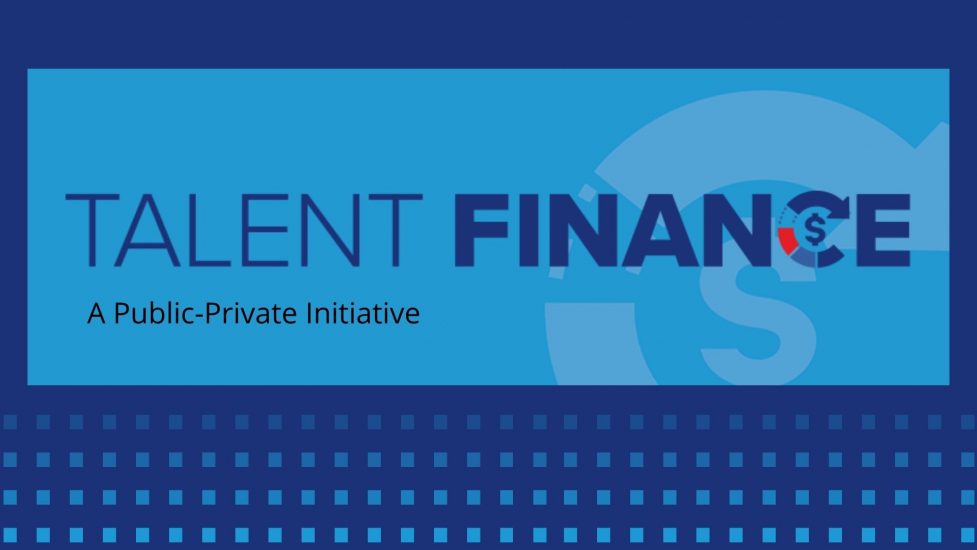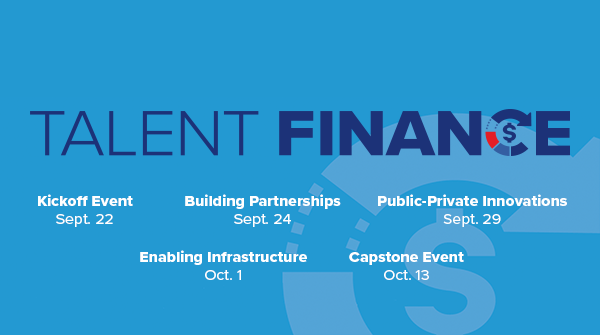The national jobs crisis – triggered by a global pandemic – has exposed hard truths about the workforce and inequities in opportunity for individuals to develop the knowledge and skills needed to remain competitive.
It’s time to rethink our public-private approach to financing workforce talent, argues Talent Finance, a new white paper released today by the U.S. Chamber of Commerce Foundation, with its partners the U.S. Chamber of Commerce, the Greater Houston Partnership, the Federal Reserve Bank of Atlanta, and WorkingNation.
We’ve all seen headlines like these:
- “Over 45 million borrowers now collectively carry nearly $1.6 trillion in debt with one in 10 borrowers unable to pay or in default.”
- “Four out of 10 college students never complete a degree with higher attrition rates for low-income and minority students.”
- “Displaced workers who are reemployed have reduced earnings ranging from 17 percent to 48 percent.”
- “As many as 40 percent of today’s jobs may permanently go away or be significantly transformed.”
These headlines are all indicative of “the undeniable truth that our current approach for financing and developing talent has perpetuated systemic and widespread gaps in equity and opportunity,” according to the white paper. “In the new economy, talent is king. We need a talent finance approach fit for our time, not one built for a different era.”
Redefining Responsibilities and Sharing the Risk
Peter Beard is senior vice president of Regional Workforce Development with Greater Houston Partnership and one of the five co-authors of the paper. “An approach to talent finance that perpetuates the status quo will not be sufficient. Employers, workers, and governments will need to redefine their roles and responsibilities in terms of making investment and managing and sharing risk,” Beard tells WorkingNation.
The paper says that, in these changing times, “the way we finance and invest in talent has not kept pace.” One of the paper’s key takeaways states “employer talent-on-demand strategies and traditional government-funded supply-side approaches have further separated work and learning and contributed to a growing skills gap.”
Difficulty Navigating Talent Pathways
Nontraditional students and those with limited financial resources are often faced with obstacles. The paper finds, “Government investment to promote greater access to traditional college pathways has not produced the expected avenues or outcomes when it comes to economic advancement and closing the equity gap.”
Additionally – according to the paper, federal spending on workforce development-related programs has been in decline since 2000. “As it stands now, these federal programs do not have the funding to reach most of the workers they target and only a portion of it is spent on actual training and skill development. These federal programs also do not have the funding nor are they designed to fully address the needs of workers who are outside of or on the margins of the labor market and served by public safety net programs.”
The Talent Finance Initiative
Talent Finance details 16 recommendations to foster change. Its rethinking of talent development includes shared value and risk, expanded choices, affordability and fairness, equity, accessibility, transparency and accountability, and worker empowerment.
Businesses are pushed to take an active role. Employers will need to “develop and engage workers to drive and support innovation” resulting in a workforce that is agile and resilient.
It also suggests that “employers will explore new employment relationships and strategies for assigning work across regular employees, contractors, and outsourcing partners.”
Calling this the “new innovation-based economy,” the findings – calling some workers “career entrepreneurs” – say, “They will take more responsibility for planning and managing their own careers and their investments in skill development…”
Employers are encouraged to lead the way on “new approaches for financing talent development that expand career pathway options for workers and provide them with meaningful credentials.” One innovative action that combines training opportunity with managed risk is Income Share Agreements (ISAs).The paper states, “While ISAs are being explored at relatively small scale at universities, with workforce boards, and through private financing, there is an opportunity to expand them considerably through direct partnerships with or investments from employers.”
Talent Finance also notes, “The federal government is the largest provider of student loans, putting out over $100 billion annually.” It suggests a change to its lending model. “The federal government could move a portion of its loan portfolio into employer-backed ISA accounts that serve as underwriting partnerships for organized talent supply chains, industry-recognized apprenticeships, staffing agencies, or state training programs.”
The risks associated with employment and income should be managed more effectively. A public-private approach could incentivize “employers to expand their economic security benefits, reduce the time spent for workers in unemployment or underemployment, and mitigate against steep drops in household earnings.” The paper continues that employers should be given incentives to “expand their financial wellness programs, employee assistance, and support services.” This employer expansion “should be done in coordination with the redesign, consolidation, and streamlining of public safety net programs.”
Time for a Paradigm Shift
The paper’s call to action is robust stating, “What we seek is nothing less than a paradigm shift.”
“I’m confident our partnership will spur innovative public-private collaborations that will advance opportunities for workers. Importantly, the initiative’s commitment to finding new financial models means that we will be able to bring successful innovations to scale, thereby helping to provide significant capacity for small- and medium-sized businesses,” says Raphael Bostic, president and CEO of the Federal Reserve Bank of Atlanta.
Finding new approaches to talent investment will, perhaps, result in future headlines reading more like this:
- “Education and training programs boast a completion rate of 90 percent or higher, with low-income and minority students closing the completion gap.”
- “Program participants guaranteed employment upon entering a training program with opportunities to earn while they learn.”
- “A majority of program completers are earning wages commensurate with the skills they attained, closing the earnings gap for women and minorities.”
- “Jobs are changing faster than ever, but employer investment in reskilling and upskilling is at an all-time high resulting in an unprecedented low rate of worker dislocation.”
To read the full paper and list of recommendations outlined in Talent Finance, click here.
Today’s release of Talent Finance white paper will be followed by a series of virtual events beginning Tuesday, September 22 and running through October 13.
The Talent Finance movement partners include the U.S. Chamber of Commerce Foundation, the U.S. Chamber of Commerce, the Federal Reserve Bank of Atlanta, Cognizant U.S. Foundation, JPMorgan Chase, Google.org, Microsoft, Schmidt Futures, and WorkingNation.
The initial forums will be followed by design workshops that will explore public-private talent finance instruments and identify pilots and partnerships with strong employer leadership. Tools and templates will help participants create their own talent finance solutions.
Jason Tyszko is vice president of the Center for Education and Workforce at the U.S. Chamber of Commerce Foundation and another of the co-authors. He says this is just the start – across the country through public-private partnerships – to fundamentally transform how we finance and invest in talent. “The Talent Finance initiative is much more than a paper and event series. Its real aim is to ignite a movement.”
In addition to Tyszko and Beard, the Talent Finance paper was written by Robert Sheets, a member of the Foundation’s Center for Education and Workforce, Stuart Andreason, Director of the Atlanta Fed’s Center for Workforce and Economic Opportunity, and Sarah Miller, Senior Advisor to the Atlanta Fed.












